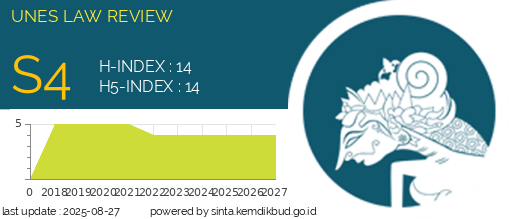Pengaruh Peran Amicus Curiae Terhadap Proses Peradilan dan Kepastian Hukum
DOI:
https://doi.org/10.31933/unesrev.v6i2.1283Keywords:
criminal justice, amicus curiae, evidenceAbstract
Evidence in criminal procedure law plays a very important role in the criminal proceedings. Because, in criminal procedural law, evidence is considered extremely important because its main purpose is to discover material truths in discovering criminal cases. To reveal the truth of the case, evidence is the main method used by the judge to determine whether the defendant committed a crime or to obtain the necessary basis to make a decision to resolve the case. Relevant evidence has been further stipulated in Article 184 of the Criminal Procedure Code, specifically: testimonies of witnesses, expert statements, letters, instructions, and statements of the accused. The evidence provision mechanism in criminal justice today is increasingly enriched thanks to the presence of the concept of amicus curiae or friend of the court. Amicus curiae is defined as a party who feels interested in a case and gives his legal opinion to the court. However, stakeholder participation is limited to providing opinions and is not intended to interfere with the judge. In the development of existing evidence and evidence mechanisms, one of them is the Amicus Curiae (Friend of the Court). Amicus Curiae is a third party who feels interested in a case, provides legal advice to the court and does not intend to interfere with the judge. Amicus curiae has not been clearly regulated in Indonesia, but in principle it is accepted based on clause 5, paragraph 1 of the Judicial Power Law "Judges and constitutional magistrates are required to learn, comply with and understand legal values and the sense of justice. exist in society. Furthermore, the admission of amicus curiae can be found in article 180, paragraph 1, of the Code of Criminal Procedure, which states that "In case it is necessary to clarify a question raised in the 'trial, the presiding judge of the court may be asked to provide expert information and may also request the parties involved to submit new documents.The premeditated murder committed by defendant Richard Eliezer in the Jakarta area is an example of a case involving amicus curiae.
Downloads
References
Pralampita, L. A. (2020). Kedudukan Amicus Curiae. Jurnal Universitas Islam Indonesia , 558-572.
Pralampita, L. A. (2020). Kedudukan Amicus Curiae Dalam Sistem Peradilan Pidana Di Indonesia. Reinasansce, 558-572.
ROZI, F. (2018). S.H.,M.H. Jurnal Yuridis Unaja, 21.
Sukinta. (2021). Konsep dan Praktik Pelaksanaan Amicus Curiae Dalam Sistem Peradilan Pidana Indonesia. Administrative Law & Governance Journal, 89-98.
ICJR. (2009, October). Pidana Penghinaan adalah Pembatasan Kemerdekaan Berpendapat yang Inkonstitusional.
Arsil. (2022, December 15). Amicus Curiae Dalam Sistem Peradilan Pidana di Indonesia. hal. 1-32.
Wibawana, W. A. (2023, January 30). Masyarakat Kirim Amicus Curiae untuk lindungi Bharada E, Apa itu? Diambil kembali dari https://news.detik.com/berita/d-6541445/masyarakat-kirim-amicus-curiae-untuk-lindungi-bharada-e-apa-itu
Haruma, I. (2023, February 10). Kompas.com. Diambil kembali dari Kompas.com: https://nasional.kompas.com/read/2023/02/10/00050011/apa-itu-amicus-curiae-
Rembeth, I. A. (2023, august 23). Meninjau Ulang Peran Amicus Curiae dalam Sistem Peradilan Pidana di Indonesia. hal. 1.
Downloads
Published
How to Cite
Issue
Section
License
Hak cipta :
Penulis yang mempublikasikan manuskripnya di jurnal ini menyetujui ketentuan berikut:
- Hak cipta pada setiap artikel adalah milik penulis.
- Penulis mengakui bahwa UNES Law Review berhak menjadi yang pertama menerbitkan dengan lisensi Creative Commons Attribution 4.0 International (Attribution 4.0 International CC BY 4.0) .
- Penulis dapat mengirimkan artikel secara terpisah, mengatur distribusi non-eksklusif manuskrip yang telah diterbitkan dalam jurnal ini ke versi lain (misalnya, dikirim ke repositori institusi penulis, publikasi ke dalam buku, dll.), dengan mengakui bahwa manuskrip telah diterbitkan pertama kali di Jurnal UNES Law Review.



















